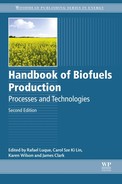8
Production of fuels from microbial oil using oleaginous microorganisms
Abstract
The utilization of microbial oil produced by oleaginous yeast and fungi as raw material for fuel synthesis could result in a sustainable process avoiding the competition with food and feed products. Oleaginous microorganisms could be cultivated in submerged fermentations by using renewable resources as feedstock including agricultural residues and industrial waste and by-product streams. This chapter focuses on the description of the potential of microbial oil production by yeast and fungi, the biochemistry of oil accumulation, and the prospect of biodiesel production from microbial oil.
Keywords
Biodiesel; Biomass; Biorefinery; Microbial oil; Oleaginous microorganisms8.1. Introduction
Bioethanol (mainly from sucrose and starchy crops) and biodiesel production (via transesterification of triglycerides) are the main first-generation biofuels that are currently produced on industrial scale. Biodiesel is produced by transesterification of triacylglycerols with short-chain alcohols (mainly methanol or ethanol) to produce monoalkyl esters, namely fatty acid methyl esters (FAMEs) and fatty acid ethyl esters (FAEEs). The worldwide production of biodiesel is mainly dependent on the utilization of waste oils, animal fats, and oilseeds such as rapeseed, sunflower, and soybeans. The recent food crisis has shown that research should focus on the development of second-generation biofuels generated from lignocellulosic raw materials and industrial waste streams (eg, food industry wastes).
In the past few years, research has focused on the development of biodiesel production from single cell oil (SCO) that can be produced via fermentation using various oleaginous microorganisms (ie, microorganisms that are able to accumulate lipids intracellularly at more than 20% of the total cellular dry weight). The proposed strategy may provide a more eco-efficient and sustainable option as compared to first-generation biofuels and second-generation bioethanol production routes utilizing lignocellulosic biomass. Potential advantages include:
• The raw materials that will be used for the production of SCO-derived biodiesel do not compete with food production. In this way, cultivation of land for food production as well as industrial food processes could coincide with biodiesel production by utilizing residues and agro-industrial wastes.
• Microbial oil could be produced from various carbon sources (eg, glucose, lactose, xylose, sucrose, glycerol) using natural microorganisms contrary to bioethanol production where natural microorganisms that are traditionally used in industrial processes utilize mainly glucose and sucrose.
• Bioethanol separation is an energy-intensive technology with significant capital investment requirements, while separation of intracellularly accumulated SCO is likely to be achieved at significantly lower capital cost and energy requirements.
• Biodiesel production from oilseeds and waste oils will never provide adequate quantities of biodiesel to sustain the worldwide demand. In addition, the production cost of oilseeds is approximately 70–80% of the total biodiesel production cost. Biodiesel production from SCO will depend on the utilization of low-value waste streams or residues and therefore will offer a sustainable option for biofuel production.
• Transesterification of SCO results in the production of crude glycerine that could be used as a platform intermediate for the production of biofuels, chemicals, and biodegradable plastics (Koutinas et al., 2007b; Aggelis, 2009).
..................Content has been hidden....................
You can't read the all page of ebook, please click here login for view all page.
